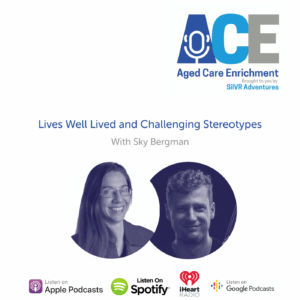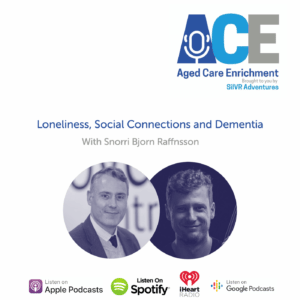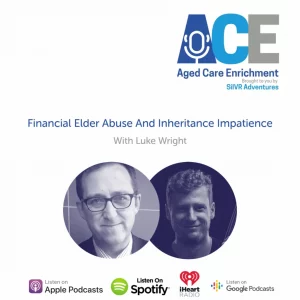Heath Shonhan is a partner at Bentley’s Chartered Accountants in Queensland, with an extensive history in advising a range of businesses across the aged care sector. He’s a vocal advocate of all businesses seeking to improve and innovate their service offerings. Either by exploiting existing elements of the business that work, or exploring peripherally related services or industries that could provide extra revenue.
His passion for helping new companies tackle big issues is present in his work with CareFactor, an early stage start-up incubator for aged tech products. Late in 2020 SilVR Adventures was thrilled to be included in CareFactor’s 20/21 cohort which saw us pitching our virtual reality experiences directly to aged care providers, under the mentorship of Heath and other business growth specialists.
This conversation is all about how aged care businesses can improve their offerings, unlock new revenue streams and embrace innovation at all levels. Heath provides some great tools such as the business model canvas and the build-measure-learn loop, to help aged care businesses achieve rapid growth.
Transcript
Ash de Neef: Heath thanks so much for joining us today on the program.
Heath Shonhan: It’s nice to be here Ash. And thank you very much for having me along, looking forward to our chat together.
Ash de Neef: Absolutely. Me too. And can we start with a little bit about your background and the work that you’re doing?
Heath Shonhan: The fullness of my professional background, I began my career at KPMG in Queensland and had a wonderful role working in the private clients or private business area with the dual focus into Asian business actually. But I wanted to continue to build my skill set and so that role was very much focused around business advisory work.
And I wanted to get a flavor for audit and corporate finance and the like. And so I did multi-skilling across different parts of the firm. Did my apprenticeship there, moved over to England and worked in both corporate development for a large pharmaceutical company. And also in one of the large banks in Liverpool street in London.
And then my third role was actually with the social housing company in the outskirts of London. So quite diverse roles before coming back to Australia after couple of years of European adventures and work experience. And ended up joining Bentleys where I am today.
And so that was 16, 17 years ago now and I’ve been a partner here for 15 odd years. And at that time, when I joined the firm, it had a great long standing presence within the aged care sector amongst other sectors, but really deeply involved in the aged care sector. Advising all manner of stakeholders, the government around financial risk and allocation of.
Capital such as zero interest loans, financial capital funders, both debt and equity. Whether it be the large banks, or institutional capital funders. Providers with their service provision, whether they be resi[dential] aged care, home care, retirement living, and then also consumers through our private client work.
And so have for the last 15 or 16 years now, I had a deep focus on the Australian aged care sector in Australian healthcare, more broadly across a few different lenses. So that’s brought me to here Ash and I actually remember 20 odd years ago, doing some multi-skilling audit thinking.
I’d been working on ASX listed public companies. And I came back on one night late, a little bit disheartened because I’d found myself working on the audit of an aged care home. And my boss at the time said to me, Heath you may end up specializing in aged care. I dismissed, but here I am. 27 years later.
Ash de Neef: Yeah. Wow. And was Bentleys association with the aged care industry and those sorts of connections. Was that what attracted you or was that a factor in choosing to join Bentleys?
Heath Shonhan: It wasn’t. Immediately the attraction was the quality of the partners and the types of clients that they were working with.
So at a very deep level, they’re two really great value drivers, and it just so happens that the health and aged care sector aligned with the firm, but also I’d had previous experience.
And it’s a sector that really grabs you Ash. It’s got such a deep social purpose and social conscience. And from a business perspective, it also has many different, very interesting overlays.
We’ve got this tension between government and society and families, and there’s a interplay of inter-generational wealth. There’s an interplay of social responsibilities or all kinds of fascinating business leaders as well as it’s very unique in that where the capital costs of providing the service are funded by the consumer.
So as a sector, that’s a very unique characteristic as well.
Ash de Neef: Yeah. Those are really good points. I’d never thought about how unique an environment it is with all those different players and there’s different factors to consider. Now something you’re quite passionate about I think Heath is innovation. And with a lot of experience in business advising you’ve probably got a lot to say about what it means to be an innovative company.
But in the space of aged care, what does it mean for an aged care provider to be innovative?
Heath Shonhan: Absolutely spot on. I am passionate about it because I believe that it’s going to be one of the great ways to move forward and really take some progressive steps in aged care, not just in Australia, but globally.
So it’s been born out of working with so many different stakeholders, looking at their pains and gains and jobs to be done from their perspectives and seeing all of these different stakeholder perspectives. It was born out of 25 years of bench-marking the aged care service provision. It was born out of 20 odd years of advising the Commonwealth around financial risk.
And being financial people are coming from that financial background, we can see there’s an increasing demand. There’s an increasing quality expectation. There’s a need for productivity. And there’s a decreasing ability for government to pay and provide the safety net that currently does at such a high level for everybody in society. And they’re historical positions, which need to change.
But putting aside some of those macro pieces, we’re passionate about innovation because we can see that it can practically move the needle on providing better outcomes for care recipients, providing better outcomes for their families, providing better outcomes for providers and providing better outcomes for the stakeholders who have vested interest in those providers, whether it be government or other service providers.
There has been successive reports, reviews, commissions, investigations, analyses of the aged care sector and what is required. And they all point to very similar things. And one of those things is the need for innovation and practical innovation delivered to not just innovation theater.
There’s a high degree of theater. Look at this, look at that. It’s, “we’re being innovative”. But it never translates into improved outcomes either for the consumers care recipients, their families, or the providers or society as a whole. So we’re trying to move the needle practically with innovation, whether it be targeted at productivity or otherwise.
Ash de Neef: Yeah. Fantastic. And how can an aged care provider differentiate between innovation theater, as you said, and genuine innovation.
Heath Shonhan: The execution premium is a big part and focusing on outcomes as opposed to the method. It’s easy to put budgets aside. It’s easy to add innovation to agendas of board meetings or executive meetings.
And indeed providers as an example, care providers are already innovating. So they are doing this. They have forms of what a called continuous improvement plans. And these continuous improvement plans are absolutely a form of incremental innovation. So it is already occurring. Signals are being done by adding it to an agenda and allocating budget to it.
But to actually deliver it is a focus on the execution, it requires a whole different skillset. Providers are doing it. Captured in their continuous improvement plans, that’s incremental innovation or some of the terms that we use it’s exploiting existing innovations in business models. And we’re big advocates also of outcome focused evidence-based and exploring new business models as well, as part of that broader innovation banner.
Yeah.
Ash de Neef: Fantastic. And you mentioned those two sides, there exploiting and exploring. Do you feel like one of those is more available to providers for example, or both skills and tool sets that can be used equally? What are your thoughts on that?
Heath Shonhan: Strategist call this the ambidextrous organization Ash.
Where you can both exploit and improve your successful and established business models and explore completely new value propositions, completely new business models and other types of growth engines. The exploit stuff is where a lot of organizations find it easy to do because it’s easy to work with their existing business model to create efficiencies or incremental change.
And really practical examples of what’s going on right now is business process re-engineering or looking at time and motion studies around staff utilization to make sure that there’s the highest and best use of different skill sets. Or the replacement of products and services with newer better features , et cetera.
That’s relatively easy and comparatively easy. And the systems around that in the organizations already to enable that. The explore side though, as I mentioned before, is all around these new value propositions, these new business models and growth engines. And so that’s where you can really move the needle.
And it’s hard for established companies to actually master the explore side because it requires very different ways of working. The culture, the skills, the processes, the incentive programs they work well for efficiency, but they’re not producing …. And I’ll give you an example.
So a key performance measure for the explore side is rate of learning and knowledge created and what evidence you’re actually creating and learning. And that isn’t a revenue or a net profit measure, which is in fact, you’ve got a cash burn and usually on the explore side of things. So the tools are different.
The tools are absolutely different. It’s in the kind of the technology world. They talk about this kind of build measure learn, or an agile type of methodology. The culture requires people who are willing to experiment and fail and look at some of that. The great companies have embedded this in their ethos.
The Amazons of the world have said, you can make mistakes. In fact, we want to, because that’s how we learn. And you get penalised when you’re exploiting your existing model if you make mistakes, because you’ve already learned a lot. So tools, we’re big fans of the business model canvas and the customer value proposition tools.
So they’re great canvases, lean canvases to be able to rapidly sketch out what your idea might be, rapid business model around it. And then start to test that before you actually spend any money.
Ash de Neef: You’re also working through Bentleys with a lot of very early stage companies at the moment in an incubator program called CareFactor
Can you maybe explain quickly what an incubator is and what CareFactor is for?
Heath Shonhan: Yeah. CareFactor we’ve put this colloquial term out there. It’s the entrepreneurial playground for Australian aged care. And the playground is a bit of a fun term to use.
But an incubator in it’s very purist sense takes ideas, takes early stage business models and helps rapidly validate the product market fit by using principles of scientific measure method. Wrapping principles such as build measure, learn, loops around and creating those collisions with the first customers to really help that product market fit validation.
And so we had a hypothesis Ash about seven, eight, nine years ago when we were still deep in the midst of benchmarking and doing all of the very typical sort of forecasting and strategy type of work that we do. And all of that forces you to think about the future. And the future was looking increasingly bleak when we started, casting our minds out five,ten years based on current trajectories.
And so we had an hypothesis seven or eight years ago that the industry wanted and needed innovation, not just the exploitation, but the exploring of new stuff. We tested that with some aged care providers where we took some specific problem statements that they had and then pitched to their board at the end of the day, saying, “Hey, we’ve got this idea.”
This is how we’re going to wrap a business model around it. This is what we need to do to test it. And this is what we need funding for. And so we ran a couple of those, this further validated our hypothesis that the sector wanted and needed innovation. We then co-designed what the program needed to look like with a whole range of stakeholders, whether it be equity, capital funders, debt capital funders, providers, government, consumers, peak bodies.
We tested it. We did our own business model canvas. We tested it. We gathered our own evidence over the period of about two years. And it culminated in the pilot of CareFactor in 2019. And so that was a 12 week program, a three-day masterclass at the front end, where we took 10 teams through a process of learning how to use these tools, how to apply scientific principles.
And how to collect evidence, build hypotheses, but then go through that rate of learning and then importantly wrap an ecosystem around them. Whether it be mentors and providers so that they could test their product market fit. The mentors to help them along the way. The subject matter experts, whether it be Austrade or the Aus industries, or, Bankers like Westpac or lawyers like Red Chip or built environment experts like Paynters, venture capital within a Sprint context.
And Bentleys driving the business strategy in this side of things, wrap these mentors around them. Take them through a 12 week program, helped them validate their product market fit. And the whole reason why we’re doing this Ash is so that we could really accelerate this process of idea through to practical, improved outcomes for the elderly in our community.
As I said too much innovation theater look at these shiny toys. We wanted to condense it down to a 12 week process from shiny toy incubated through this 12 week program. So that it’s actually a real usable tool. To provide better outcomes for the elderly. And so that’s an incubator, it takes the early stage ideas.
And so we piloted in our program in 2019 under our own build measure, learn loop. We had some great learnings around that. Part of those learnings was to increase the validation of the team’s product fit with aged providers. And so we took it from 10 teams in 2019 to close to 50 aged care providers.
I’d like to think that the teams that are going through the current CareFactor cohort, which culminates in pitch day on the 23rd of March 2021, are really benefiting from those collisions, with their customers through this 10 by 10 minute speed dating.
And to give you some insight the teams this year. We had 52 applicants from entrepreneurs who look at aged care as a great thematic and want to solve some problems or, social entrepreneurs. We had universities and teams from universities, such as QUT advanced robotic teams looking to spin out and do a tech transfer. So translate their research into a practical commercial setting.
And then we had teams that were actually intrepreneurs within an aged care organizations looking to wrap a business model around. And so those 52 teams, we interviewed 20 of them and we’re taking 10 through the program of which SilVR Adventures is one of them.
And part of the reason why, the teams got through to it, through such a competitive process was their focus and alignment with our core objective of providing better outcomes for the elderly in our community and willing to. To trust us that we will actually help make a difference going through this process.
So we’re incubating 10 organizations at the moment to really improve the outcomes. And they’re part of a broader ecosystem Ash. So it takes a village to raise a child and CareFactor is just one component of that ecosystem, which is why we use this term, this entrepreneurial playground for aged care.
We’re lucky. I’m very privileged to be able to have access to government, have access to all different stakeholders, have access to board and executive level aged care providers. On a daily basis. And so one of the ways that we thought we could help practically again, to lose the innovation theater, the way that we could help practically was to put our arms around all of the people that we know in the sector use our role as a privileged intermediary and a trusted intermediary to provide a program, to improve outcomes focused on innovation.
Ash de Neef: Fantastic. And it sounds like there’s a lot of value there for the companies that are being incubated, but also the industry as a whole, and any providers that might start to work with these companies, how can care providers get involved with CareFactor or the companies that are being incubated?
Heath Shonhan: Yeah, Ash that’s spot on. When we were developing up, we use our own tools so practice what we preach. And so we did a value proposition, canvas for stakeholders, for government around CareFactor for the teams to go through the program, through sponsors and importantly, through the care providers for the care providers and the return on investment that we believed and has been tested and is, really translating well for those that are involved.
Is that, the providers that are involved with CareFactor and that do becomee involved in this product market fit validation. They get the front row seat as to what is actually really happening in a validated context. Remember the 10 teams that are going through this process have been through a comprehensive filtering and assessment process.
And so they’re getting access to something that’s been through a filter. That because otherwise they get knocks on the door every day. The way the providers is so busy and remember their key jobs to be done are delivering 24/7 quality care looking after the care recipients and the family members and all the stakeholders around them that they’re large workforce providers.
And so absolutely not all of it is going to work. That’s the whole idea of such early stage innovation. But part of it is to help answer that question really early on for all of these teams, so that they don’t waste precious time and resources is, do I pivot? Is this hitting the mark for providers? Do I persevere or do I kill this idea?
Do I no longer wait wasting any resources? And the providers that are involved in that process, they’re seeing validated innovation. They get the opportunity to be able to pilot these innovations in their own organization. And usually because I’m going out on a limb here, but usually because the companies that we’re dealing with, the enterprises that we’re dealing with, going through CareFactor are such early stage the opportunity to have a pilot.
Paid if possible to share the cost, but even an unpaid pilot, is gold to be able to point to proof of concept being validated in market. So the opportunity for providers to be able to get these pilots of technologies that are truly going to help either increase their revenue or decrease their cost.
Remember some of these teams and organizations going through CareFactor, have the ability to add additional revenue from new markets to aged care providers. Not just their existing revenue sources of government subsidies or resident fees. Currently 70% of money comes from government and 30% comes from residents subsidies the opportunity for providers to be able to access alternative revenue sources via the innovations.
Being driven through CareFactor is an incredible return on investment value proposition for them.
Ash de Neef: Yeah, fantastic. And for those care providers that haven’t been involved in the incubation process, there is the public web event, the pitch day on the 23rd of March, where can people find out more about that?
Heath Shonhan: Bentleys.com.au/CareFactor. And it will be a full online digital event this year. This is one of the learnings that we’ve had to go through is a pivot to online slash digital. To facilitate teams where we can’t meet in person and get that collaborative energy. So that’s been a great learning experience for us, by the way.
One of the real big upsides of that though, is that we’ve been able to go global and to accept some international teams that have an interest in solving Australian aged care problems. So thanks to our international partners such as Austrade the CareFactor word has gone global and the program has now gone global. So it’s really great to see.
But in terms of being able to find more information about the pitch day or about CareFactor more generally Bentleys.com.au/CareFactor
Ash de Neef: Now, previously, just before you mentioned investment and you’re someone who’s through Bentleys and also outside of Bentley’s leading investment into aged care.
What message would you like to convey to people who are working within the industry about the investment that’s coming in?
Heath Shonhan: So from an investor’s perspective, aged care has a number of really great attributes. There’s an underpinning demographic thematic.
So we’ve got a society that is aging exponentially. There’s high degrees of government funding, a fragmented marketplace. So purely wearing an investor hat, those three things provide great opportunities.
You’ve got reasonable certainty around your recurrent revenue streams. You’ve got an underpinning increase in your customer base and there’s perceived inefficiencies for fragmented service provision.
So that’s the investor’s lens on aged care. And if you can focus on those positives… and talking to the aged care providers in situ thinking about this externally, there’s a range of opportunities to be able to attract investment. Because as a subject matter expert, you know best what needs to be done and also, how to deploy it.
So the message is, you’ve got an amazing in-situ perspective and the experience-base there to capitalize upon those investor perspectives. And it’s a sector that wants and needs innovation. Innovation is rewarded by investment. Financial capital flows to innovation, particularly when there’s a return on investment.
And clearly there is that opportunity here. And so the ability to implement technology to completely improve ways – so the exploit side or to develop brand new business models within aged care. So imagine applying something like the subscription business model, the Netflix business model to aged care Ash.
And imagine if you were to transform the current aged care business model, which is government pays for service. Resident pays for what they can afford and under a means-tested arrangement. To it’s a subscription paid for by the family or a subscription paid by the insurance company. So business model innovation, but to deliver that, they arethe people with the connections in the sector are best placed to marshal the resources and get customer access.
Because generally they’ll have friends in or colleagues who have worked in a whole range of different aged care providers. And so the ability to get first customers is usually another great advantage that they have as well.
Ash de Neef: Yeah, that’s a really great message. It’s a very timely one as well I think. We’re recording this in the middle of February 2021 and very shortly, the Royal commission’s final reports will be released by the time this goes to air it’ll after that.
But I think that to hear that not only is the hope and anticipation of change out of the Royal commission’s findings. But also that there is interest from investors and innovative companies and entrepreneurs to contribute to this culture of change is not just pinning all our hopes on a government change, but from within and from without there’s also a desire to change and a will to change.
Heath Shonhan: I fully agree with that sentiment. And there will be signals and support provided by government and necessarily so as they’re a key market maker within this sector and they will be super helpful. However, at the same time, going back to the point before around execution is actually up to all of the stakeholders and the whole of the ecosystem to be able to support that change and that evolution.
Which looping CareFactor back into the discussion Ash thats exactly the way that we thought we could use our skills to support that evolution. And this is not a new requirement and it won’t go away tomorrow. And so we’re really grateful for the industry support we’ve received so far. We’re really grateful for the teams that have shown interest in being a part of that ecosystem or that entrepreneurial playground.
We’re grateful for the sponsors, Telstra, Westpac, Paynters, Redchip, Sprint, Global Centre for Modern Ageing, Austrade. We’re grateful for all our sponsors, I think I’ve got them all there and partners for supporting the ecosystem but we need to do more. We’re ready to help – to do more.
And part of I guess my ask is several fold.
We want more entrepreneurs. We want more people who want to solve the problems of aged care. They’re well-documented, they’re well known. The pains and the gains are there. We want people who want to improve the lives of the elderly. We want universities to help. We want to help you translate your technology and research into a commercial setting. And the intrepreneurs the aged care providers out there that have got an idea and innovation that they want to exploit.
We want to help you wrap a commercial business model around that. So there are our asks from a team perspective. We have an ask, an ongoing ask from providers that if you want a front row seat for innovation, if you want to be able to get access to this curated innovation that’s coming through the program, sign up via the Bentleys.com.au/CareFactor website.
We’ve got great validation this year from running the project even in a digital format. So it gives me inspiration to continue to run this moving forward and to do that, we need the teams. We need the providers. We need the support from as sponsors. And we’re grateful for the support that we received so far.
Ash de Neef: Fantastic Heath. Thank you so much for your time today, and thanks for sharing your expertise
Heath Shonhan: Thank you so much.




